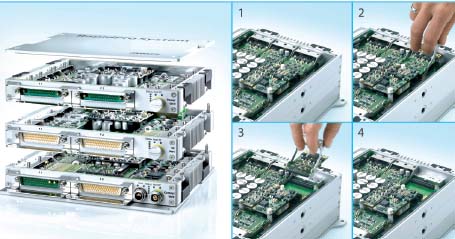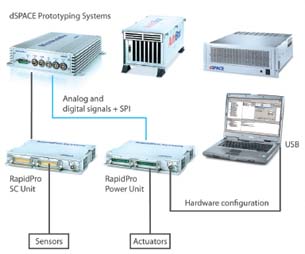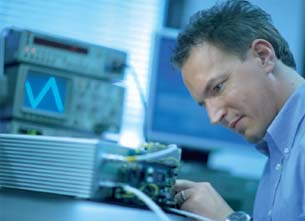RapidPro: Fast & Flexible Control
RapidPro by dSPACE allows automotive designers, in particular, to do their work more efficiently.
Latest News
May 1, 2011
By Barbara G. Goode
Targeting common tasks such as transmission controller development, powertrain electrification, and fuel consumption optimization, Paderborn, Germany-based dSPACE GmbH recently introduced standard configurations of RapidPro, its modular signal conditioning and power stage hardware for rapid control prototyping (RCP). RCP enables quick testing and iteration of control strategies in real-time on a computer, with the input/output devices being planned for the design. dSPACE’s new entry represents the latest step in the evolution of a product that aims to enable “control engineering in a convenient way,” according to Holger Ross, dSPACE’s product engineer, Rapid Prototyping Systems.
 Figure 1. Sensors and actuators are adapted for rapid control prototyping with the help of the RapidPro Signal Conditioning Unit and the RapidPro Power Unit. The MicroAutoBox unit is at upper left. |
As a pioneer in RCP, dSPACE originally created RapidPro to not only combine the advantages of flexibility, which is traditionally hard-won through custom design, and off-the-shelf availability, which typically means limited flexibility, but to deliver these advantages in a compact format. The space consideration is critical for some applications, including automotive.
“There is only very limited space available under the car seat or in the trunk,” says Ross, explaining that “highly scalable housing” is one feature distinguishing RapidPro. The modular concept means that all components can be reused, reconfigured (either via hardware or software), or extended if requirements of a project change. The components can also be used in later projects.
Hardware flexibility via its modular I/O is the reason Mark Wilcutts of Tula Technology chose RapidPro for his company’s automotive powertrain RCP work. Tula, based in Santa Clara, CA, is working to apply digital signal processing to overcome a longstanding problem: Making sure drivers have maximum power and torque during the occasional times when they need it—without compromising on efficiency during the majority of the time, when they don’t. “Basically,” says Wilcutts, RapidPro “has enabled full-authority powertrain control development at our company.”
 Figure 2. The RapidPro hardware consists of three unit types and 19 interchangeable modules that easily snap into place. The flexibility enabled by this design is a key advantage customers cite for choosing RapidPro. |
Flexibility is also the reason that ArvinMeritor (Troy, MI), provider of drivetrain mobility and braking solutions for truck, trailer, and specialty vehicle original equipment manufacturers (OEMs), chose RapidPro for development of advanced chassis and driveline systems on development vehicles. Although the company uses multiple rapid prototyping systems, RapidPro allowed the team the flexibility to configure the hardware, specifically the sensor and actuator characterization, to meet the requirements of a specific application. As Jon Honig, engineering manager for controls, software and mechatronics in ArvinMeritor’s Advanced Engineering & Electronics unit, explains, “RapidPro was selected to implement fuel injector drivers to help reduce system response time.” Honig says that using RapidPro allowed his team to focus its efforts on system and controls development.
Automotive and Beyond
While the majority of dSPACE’s customer base is in the automotive industry, RapidPro has broad application in other areas such as aerospace and industrial settings. All these applications can involve a wide variety of sensors and actuators—especially during the rapid prototyping phase—and each one may require its own signal conditioning and power stage circuits.
Connecting the sensors and actuators to the prototyping system can be an expensive, time-consuming design and implementation task. But with RapidPro, there is no need to do soldering, signal adaptation or circuit design, says Ross (see Figure 1). Efficient RCP is a matter of choosing the appropriate module and hooking up the sensors. RapidPro takes care of configuring the signal conditioning and power stage hardware, as well.
 Figure 3. RapidPro can be tailored for specific applications. Engineers working with it should spend time to configure the hardware properly. |
Units and Modules
“The broad range of sensor and actuator interfaces demands a high level of flexibility during signal adaptation,” says Ross. dSPACE addresses this need through a range of specialty signal conditioning and power stage modules that can be adapted in terms of interface.
dSPACE’s approach to RCP allows users to design embedded software in the MATLAB/Simulink (MathWorks) environment, and then execute that in high-performance, real-time hardware. In addition, RapidPro works as an extension to other prototyping hardware, so it requires either MicroAutoBox or one of dSPACE’s other units.
The software that comes with RapidPro, dSPACE’s ConfigurationDesk, enables control over certain signal conditioning and power stage characteristics. It also allows monitoring of the power stage states to highlight any malfunctioning.
The RapidPro hardware consists of three unit types and 19 interchangeable modules (see Figure 2). The units are aluminum boxes with slots for modules. They are designed so that you can use the units separately—or connect several of them to build a stack for use as one physical unit.
An integrated unit connection bus (UCB) allows you to connect several RapidPro SC or power units directly to the control unit without external wiring. The fanless architecture was designed for maximum acceptable power dissipation to even hold power stage modules with output currents up to 60A. Shock and vibration resistance, along with temperature and voltage ranges, make RapidPro suitable for not only laboratory/test bench use but also in-situ use. The three unit types include:
- signal conditioning (SC) unit, which provides slots to install SC modules;
- power unit, with slots for power stage modules; and
- control unit, a box equipped with a microcontroller module (Freescale MPC565) and slots for SC and communication modules.
For its 19 modules, dSPACE uses a naming convention that identifies the modules’ main features. The initial letters indicate module category (for instance, SC for signal conditioning and PS for power stage). Following that is the input/output specification (AI for analog input, DI for digital input, etc.), followed by number of channels and then variant identification. For instance, the SC-DO 8/1 is a digital output signal conditioning module providing eight decoupled open drain outputs, while SC-DO 8/2 is also a digital output signal conditioning module, but with eight galvanically isolated push-pull outputs able to operate in a variety of output modes.
In addition to multi-purpose module functionalities such as analog and digital I/O and sensor supply, dSPACE’s array of modules includes application-specific offerings. Modules specific to engine management, for instance, capture the camshaft and crankshaft position, connect lambda probes and knock sensors, and generate injection and ignition pulses. Half- and full-bridge modules able to deliver peak currents up to 60A address applications in electrical drives and valves, while another module allows for the universal control of brushless electric motors. Each module has its own operating specs, which are outlined in dSPACE’s RapidPro System Installation and Configuration Reference.
According to Ross, elements such as filters, voltage dividers, and pull-up/down resistors can be inserted on the modules wherever required, and the ConfigrationDesk software allows users to control settings such as the voltage ranges, signal inversion, and special behavior modes. “Module-specific diagnostic and error messages are output, and the pinout list is generated as an aid for configuring the cable harness,” Ross notes.
Tackling Complexity
RapidPro competes with products from National Instruments (for instance, LabVIEW paired with a reconfigurable I/O product such as CompactRIO), The ETAS Group, Opal RT and PrecisionMBA. Although NI lists its pricing information online, dSPACE is more circumspect, with no pricing published; dSPACE hopes that interested engineers will call the company for pricing. However, word on the street is that a RapidPro system for a six-cylinder combustion engine costs about $14,000, and a configuration for electric motor control runs around $7,000. Add to that the cost of the core RCP system (such as MicroAutoBox).
“For simpler engines, cheaper solutions exist,” says Wilcutts. “Also, at automotive OEMs, there will be development ECUs available for which a bypass-only solution—say, using a MicroAutoBox—may be all that is needed.”
But Wilcutts says he would recommend RapidPro for working with “control systems for advanced engines with many controllable features, or for controlling multiple engines with differing I/O sets.”
Honig advises that, because RapidPro can be tailored for each application, similar to a hardware-in-the-loop (HIL) system, engineers thinking about this type of solution “spend sufficient time early in development to specify and configure the hardware properly.”
One example of RapidPro’s ability to “pre-process” sensor data and generate complex control signals comes from the field of engine control. Here, motor angle must be calculated with the help of output from crankshaft and camshaft sensors. Highly precise, rapid pulses are generated from this data to control the ignition and injection systems. This means that rapid pulse sequences must be processed at high engine speeds, and also that complex calculations must be made for angle interpolation and for the generation of multiple pulses. The calculations necessary for this would cause such a load on the main RCP system that the valuable processing power for the actual controller model would be lost. To address this, RapidPro offers a field-programmable gate array (FPGA)-based unit with an additional I/O controller, which offers special signal preprocessing to relieve the strain on the RCP system’s main processor.
More Info:
ArvinMeritor
dSPACE International
The MathWorks
Tula Technology
Barbara G. Goode served as editor-in-chief for Sensors magazine for nine years, and currently holds the same position at BioOpticsWorld, which covers optics and photonics for life science applications. Contact her via [email protected].
Subscribe to our FREE magazine, FREE email newsletters or both!
Latest News
About the Author
DE’s editors contribute news and new product announcements to Digital Engineering.
Press releases may be sent to them via [email protected].






